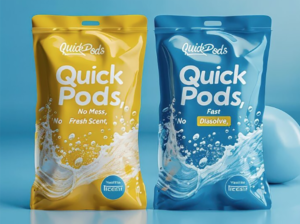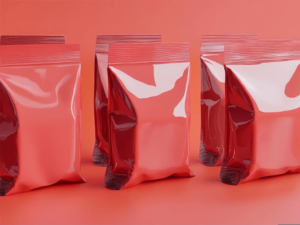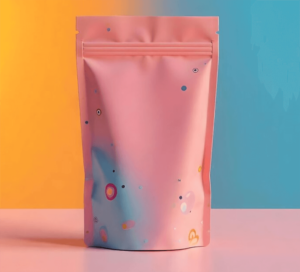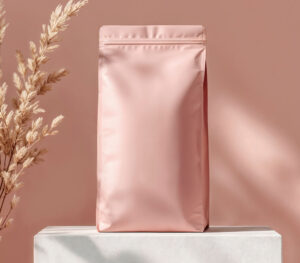Flat Bottom Pouch (also known as Box Pouch, Square Bottom Pouch, or Eight-Side Seal Pouch):
- Bottom Structure: Features a completely flat, rectangular or square base. This solid bottom provides exceptional stability, allowing the pouch to stand firmly even when partially empty.
- Sides/Panels: Typically has five printable panels: front, back, left side, right side, and the bottom. This offers more surface area for branding, product information, and eye-catching graphics.
- Shape: Resembles a box or brick, offering a more rigid and premium feel.
- Capacity: Due to its box-like shape, it often offers a larger internal volume for a given footprint compared to a stand-up pouch, making it ideal for bulkier or heavier products (e.g., coffee, pet food, dry goods).
- Filling: Can be easier to fill due to the wider, more open top.
- Manufacturing Complexity & Cost: Generally more complex to manufacture, which can lead to a slightly higher production cost.
- Shelf Presentation: Provides a strong, stable, and impactful shelf presence, often associated with higher-end products.

Stand-Up Pouch (often with a Doypack, K-seal, or Plow Bottom):
- Bottom Structure: Has a gusseted bottom (a folded-in or “pleated” section) that expands when the pouch is filled, allowing it to stand upright. This gusset can be rounded (Doypack), K-sealed, or plow bottomed.
- Sides/Panels: Typically has three printable panels: front, back, and the gusseted bottom (though the bottom is less prominently displayed than a flat bottom pouch).
- Shape: Tends to be more flexible and less rigid than a flat bottom pouch, often having a more rounded or teardrop shape at the bottom when filled.
- Capacity: While it can hold a good amount of product, the internal volume for a given footprint might be slightly less efficient than a flat bottom pouch. Better suited for lighter or more flexible contents.
- Filling: Can be slightly trickier to fill compared to a flat bottom pouch due to the gusset.
- Manufacturing Complexity & Cost: Generally simpler to manufacture, making them a more cost-effective option.
- Shelf Presentation: Still offers good shelf presence due to its ability to stand upright and can be highly customizable with various features and designs.
Here’s a breakdown of their key features and what makes them popular:
Key Features:
- Flat Base: The most defining characteristic is their completely flat, rectangular or square bottom. This provides exceptional stability, preventing tipping and ensuring a strong shelf presence.
- Multiple Printable Panels: Unlike many other pouch styles, flat bottom pouches typically have five distinct printable surfaces: the front, back, two side gussets, and the bottom. This offers extensive real estate for branding, product information, vibrant graphics, and marketing messages.
- Box-like Shape: When filled, they take on a rigid, box-like form, which often conveys a sense of quality and allows for efficient stacking and storage.
- High Capacity: Due to their boxy structure, they can often hold a larger volume of product for their footprint compared to other flexible packaging options, making them ideal for bulkier or heavier items.
- Easy Filling: The wide, open top makes them relatively easy to fill during the manufacturing process.
- Durability and Protection: They are typically constructed from multiple layers of high-barrier materials (such as plastic, foil, or paper laminates) to protect the contents from moisture, oxygen, light, and other external factors, extending shelf life.
Resealable Options: Many flat bottom pouches come with convenient resealable features like zippers (including “pocket zippers” that tuck away neatly), allowing consumers to re-close the pouch after each use to maintain product freshness. Other options like tear notches and degassing valves (especially for coffee) are also common.
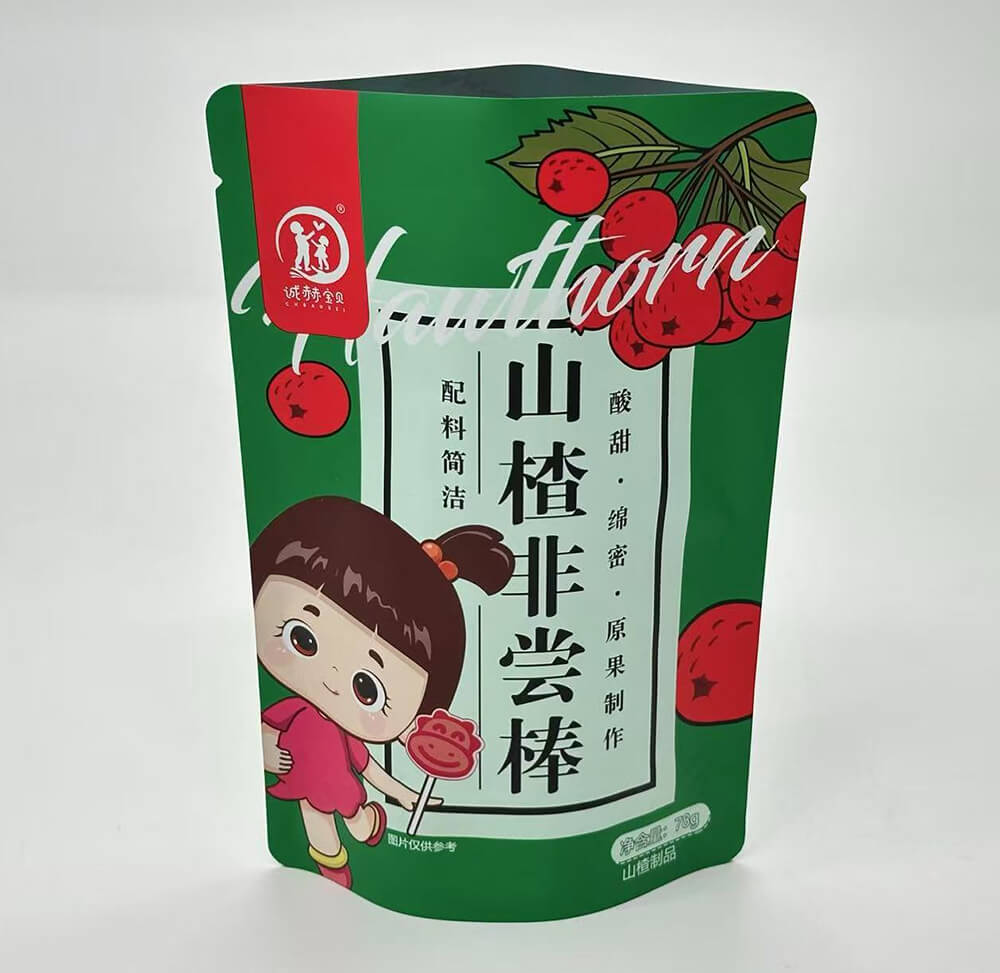
Flat bottom pouches are favored for products where stability, premium presentation, and efficient storage are crucial. They are widely used for:
- Coffee: A very popular choice for whole bean and ground coffee due to their stability, ability to incorporate degassing valves, and ample branding space.
- Pet Food & Treats: Their sturdy nature and capacity make them excellent for various sizes of pet food.
- Dry Goods: Cereals, granola, nuts, grains, rice, pasta, and other dry food items.
- Snacks: Premium snacks, biscuits, and chips.
- Powders: Protein powders, baking mixes, and other powdered products.
- Confectionery: Candies and chocolates.
- Non-Food Items: Detergents, chemicals, gardening products (like seeds), and certain cosmetics.
Advantages:
- Superior Shelf Presence: Their ability to stand upright and their distinct, high-end appearance make them stand out on retail shelves.
- Maximized Branding: Five printable panels offer abundant space for impactful designs and essential product information.
- Enhanced Stability: Ideal for products that need to remain upright and stable during transport and on display.
- Efficient Space Utilization: Their rectangular shape allows for efficient packing and stacking.
- Product Protection: Multi-layer construction provides excellent barrier properties, preserving freshness.
While generally more complex and sometimes more expensive to produce than standard stand-up pouches, their benefits in terms of presentation, functionality, and consumer convenience often justify the investment for brands aiming for a premium market position.

